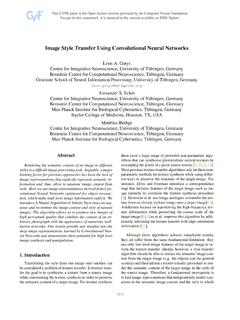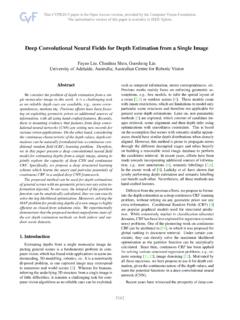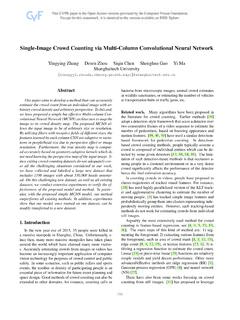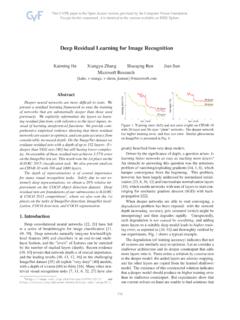Transcription of Multi-View Convolutional Neural Networks for 3D Shape ...
1 Multi-View Convolutional Neural Networks for 3D Shape Recognition Hang Su Subhransu Maji Evangelos Kalogerakis Erik Learned-Miller University of Massachusetts, Amherst Abstract has recently emerged due to the introduction of large 3D. Shape repositories, such as 3D Warehouse, TurboSquid, and A longstanding question in computer vision concerns the Shapeways. For example, when Wu et al. [37] introduced representation of 3D shapes for recognition: should 3D the ModelNet 3D Shape database, they presented a classi- shapes be represented with descriptors operating on their fier for 3D shapes using a deep belief network architecture native 3D formats, such as voxel grid or polygon mesh, or trained on voxel representations. can they be effectively represented with view-based descrip- While intuitively, it seems logical to build 3D Shape clas- tors? We address this question in the context of learning sifiers directly from 3D models, in this paper we present to recognize 3D shapes from a collection of their rendered a seemingly counterintuitive result that by building clas- views on 2D images.
2 We first present a standard CNN ar- sifiers of 3D shapes from 2D image renderings of those chitecture trained to recognize the shapes' rendered views shapes, we can actually dramatically outperform the classi- independently of each other, and show that a 3D Shape fiers built directly on the 3D representations. In particular, can be recognized even from a single view at an accuracy a Convolutional Neural network (CNN) trained on a fixed set far higher than using state-of-the-art 3D Shape descriptors. of rendered views of a 3D Shape and only provided with a Recognition rates further increase when multiple views of single view at test time increases category recognition accu- the shapes are provided. In addition, we present a novel racy by a remarkable 8% (77% 85%) over the best mod- CNN architecture that combines information from multiple els [37] trained on 3D representations. With more views views of a 3D Shape into a single and compact Shape de- provided at test time, its performance further increases.
3 Scriptor offering even better recognition performance. The One reason for this result is the relative efficiency of the same architecture can be applied to accurately recognize 2D versus the 3D representations. In particular, while a full human hand-drawn sketches of shapes. We conclude that resolution 3D representation contains all of the information a collection of 2D views can be highly informative for 3D. about an object, in order to use a voxel-based representa- Shape recognition and is amenable to emerging CNN archi- tion in a deep network that can be trained with available tectures and their derivatives. samples and in a reasonable amount of time, it would ap- pear that the resolution needs to be significantly reduced. For example, 3D ShapeNets use a coarse representation of 1. introduction Shape , a 30 30 30 grid of binary voxels. In contrast a sin- One of the fundamental challenges of computer vision is gle projection of the 3D model of the same input size corre- to draw inferences about the three-dimensional (3D) world sponds to an image of 164 164 pixels, or slightly smaller from two-dimensional (2D) images.
4 Since one seldom has if multiple projections are used. Indeed, there is an inherent access to 3D object models, one must usually learn to rec- trade-off between increasing the amount of explicit depth ognize and reason about 3D objects based upon their 2D ap- information (3D models) and increasing spatial resolution pearances from various viewpoints. Thus, computer vision (projected 2D models). researchers have typically developed object recognition al- Another advantage of using 2D representations is that gorithms from 2D features of 2D images, and used them to we can leverage (i) advances in image descriptors [22, 26]. classify new 2D pictures of those objects. and (ii) massive image databases (such as ImageNet [9]) to But what if one does have access to 3D models of each pre-train our CNN architectures. Because images are ubiq- object of interest? In this case, one can directly train uitous and large labeled datasets are abundant, we can learn recognition algorithms on 3D features such as voxel occu- a good deal about generic features for 2D image catego- pancy or surface curvature.
5 The possibility of building such rization and then fine-tune to specifics about 3D model pro- classifiers of 3D shapes directly from 3D representations jections. While it is possible that some day as much 3D. 1945. CNN1. CNN1 bathtub bed chair desk CNN1 View dresser CNN2. pooling .. toilet CNN1. 3D Shape model rendered with 2D rendered our Multi-View CNN architecture output class different virtual cameras images predictions Figure 1. Multi-View CNN for 3D Shape recognition (illustrated using the 1st camera setup). At test time a 3D Shape is rendered from 12. different views and are passed thorough CNN1 to extract view based features. These are then pooled across views and passed through CNN2 to obtain a compact Shape descriptor. training data will be available, for the time being this is a 2. Related Work significant advantage of our representation. Our method is related to prior work on Shape descriptors Although the simple strategy of classifying views inde- for 3D objects and image-based CNNs.
6 Next we discuss pendently works remarkably well (Sect. ), we present representative work in these areas. new ideas for how to compile the information in multi- ple 2D views of an object into a compact object descrip- tor using a new architecture called Multi-View CNN (Fig. 1 Shape descriptors. A large corpus of Shape descriptors and Sect. ). This descriptor is at least as informative for has been developed for drawing inferences about 3D objects classification (and for retrieval is slightly more informative) in both the computer vision and graphics literature. Shape than the full collection of view-based descriptors of the ob- descriptors can be classified into two broad categories: 3D. ject. Moreover it facilitates efficient retrieval using either Shape descriptors that directly work on the native 3D repre- a similar 3D object or a simple hand-drawn sketch, without sentations of objects, such as polygon meshes, voxel-based resorting to slower methods that are based on pairwise com- discretizations, point clouds, or implicit surfaces, and view- parisons of image descriptors.
7 We present state-of-the-art based descriptors that describe the Shape of a 3D object by results on 3D object classification, 3D object retrieval using how it looks in a collection of 2D projections. 3D objects, and 3D object retrieval using sketches (Sect. 4). With the exception of the recent work of Wu et al. [37]. which learns Shape descriptors from the voxel-based repre- Our Multi-View CNN is related to jittering where trans- sentation of an object through 3D Convolutional nets, pre- formed copies of the data are added during training to learn vious 3D Shape descriptors were largely hand-designed . invariances to transformations such as rotation or transla- according to a particular geometric property of the Shape tion. In the context of 3D recognition the views can be surface or volume. For example, shapes can be represented seen as jittered copies. The Multi-View CNN learns to com- with histograms or bag-of-features models constructed out bine the views instead of averaging, and thus can use the of surface normals and curvatures [15], distances, angles, more informative views of the object for prediction while triangle areas or tetrahedra volumes gathered at sampled ignoring others.
8 Our experiments show that this improves surface points [25], properties of spherical functions defined performance (Sect. ) and also lets us visualize informa- in volumetric grids [16], local Shape diameters measured at tive views of the object by back-propagating the gradients densely sampled surface points [4], heat kernel signatures of the network to the views (Fig. 3). Even on traditional on polygon meshes [2, 19], or extensions of the SIFT and image classification tasks Multi-View CNN can be a better SURF feature descriptors to 3D voxel grids [17]. Develop- alternative to jittering. For example, on the sketch recogni- ing classifiers and other supervised machine learning algo- tion benchmark [11] a Multi-View CNN trained on jittered rithms on top of such 3D Shape descriptors poses a number copies performs better than a standard CNN trained with the of challenges. First, the size of organized databases with same jittered copies (Sect. ). annotated 3D models is rather limited compared to image datasets, , ModelNet contains about 150K shapes (its 40.)
9 Pre-trained CNN models, data, and the complete source category benchmark contains about 4K shapes). In contrast, code to reproduce the results in the paper are available at the ImageNet database [9] already includes tens of millions of annotated images. Second, 3D Shape descriptors tend to 946. be very high-dimensional, making classifiers prone to over- to combine the view-based descriptors for 3D Shape recog- fitting due to the so-called curse of dimensionality'. nition. Most methods resort to simple strategies such as per- On the other hand view-based descriptors have a number forming exhaustive pairwise comparisons of descriptors ex- of desirable properties: they are relatively low-dimensional, tracted from different views of each Shape , or concatenating efficient to evaluate, and robust to 3D Shape representation descriptors from ordered, consistent views. In contrast our artifacts, such as holes, imperfect polygon mesh tessela- Multi-View CNN architecture learns to recognize 3D shapes tions, noisy surfaces.
10 The rendered Shape views can also be from views of the shapes using image-based CNNs but in directly compared with other 2D images, silhouettes or even the context of other views via a view-pooling layer. As a hand-drawn sketches. An early example of a view-based result, information from multiple views is effectively accu- approach is the work by Murase and Nayar [24] that rec- mulated into a single, compact Shape descriptor. ognizes objects by matching their appearance in parametric eigenspaces formed by large sets of 2D renderings of 3D 3. Method models under varying poses and illuminations. Another ex- ample, which is particularly popular in computer graphics As discussed above, our focus in this paper is on devel- setups, is the LightField descriptor [5] that extracts a set of oping view-based descriptors for 3D shapes that are train- geometric and Fourier descriptors from object silhouettes able, produce informative representations for recognition rendered from several different viewpoints.











